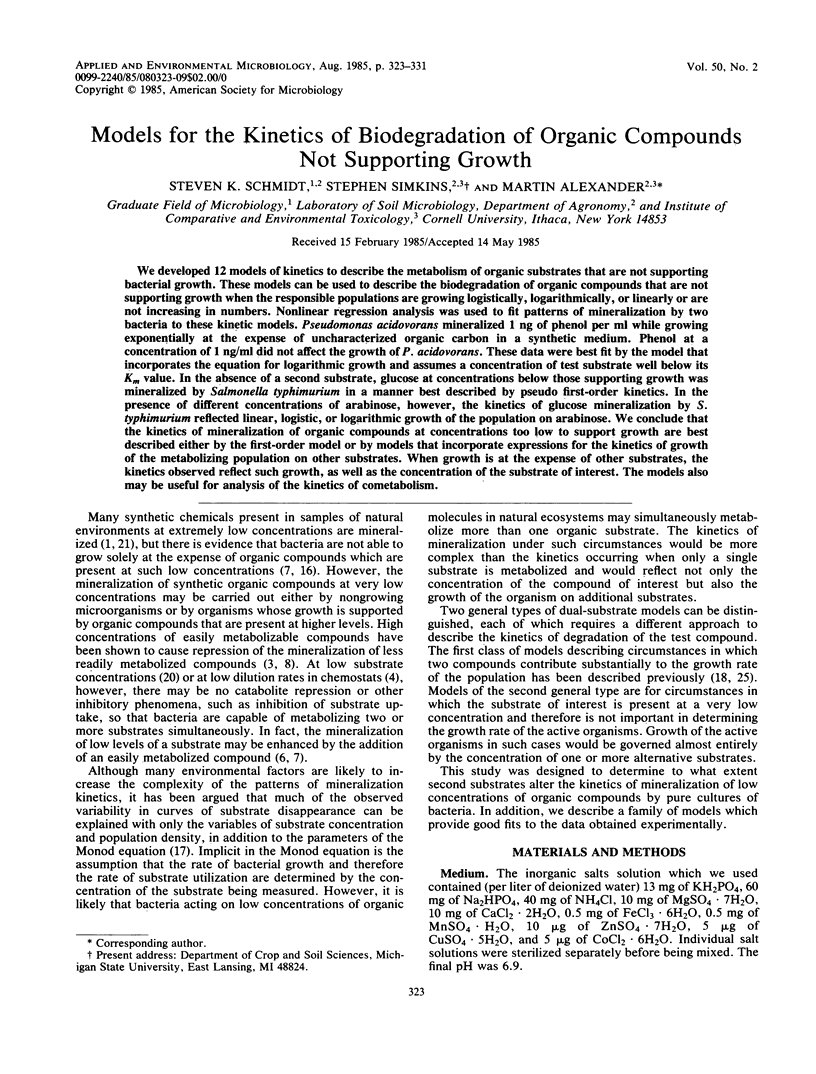Abstract
We developed 12 models of kinetics to describe the metabolism of organic substrates that are not supporting bacterial growth. These models can be used to describe the biodegradation of organic compounds that are not supporting growth when the responsible populations are growing logistically, logarithmically, or linearly or are not increasing in numbers. Nonlinear regression analysis was used to fit patterns of mineralization by two bacteria to these kinetic models. Pseudomonas acidovorans mineralized 1 ng of phenol per ml while growing exponentially at the expense of uncharacterized organic carbon in a synthetic medium. Phenol at a concentration of 1 ng/ml did not affect the growth of P. acidovorans. These data were best fit by the model that incorporates the equation for logarithmic growth and assumes a concentration of test substrate well below its Km value. In the absence of a second substrate, glucose at concentrations below those supporting growth was mineralized by Salmonella typhimurium in a manner best described by pseudo first-order kinetics. In the presence of different concentrations of arabinose, however, the kinetics of glucose mineralization by S. typhimurium reflected linear, logistic, or logarithmic growth of the population on arabinose. We conclude that the kinetics of mineralization of organic compounds at concentrations too low to support growth are best described either by the first-order model or by models that incorporate expressions for the kinetics of growth of the metabolizing population on other substrates. When growth is at the expense of other substrates, the kinetics observed reflect such growth, as well as the concentration of the substrate of interest.(ABSTRACT TRUNCATED AT 250 WORDS)
Full text
PDF








Selected References
These references are in PubMed. This may not be the complete list of references from this article.
- Boethling R. S., Alexander M. Effect of concentration of organic chemicals on their biodegradation by natural microbial communities. Appl Environ Microbiol. 1979 Jun;37(6):1211–1216. doi: 10.1128/aem.37.6.1211-1216.1979. [DOI] [PMC free article] [PubMed] [Google Scholar]
- Brunner W., Focht D. D. Deterministic three-half-order kinetic model for microbial degradation of added carbon substrates in soil. Appl Environ Microbiol. 1984 Jan;47(1):167–172. doi: 10.1128/aem.47.1.167-172.1984. [DOI] [PMC free article] [PubMed] [Google Scholar]
- LaPat-Polasko L. T., McCarty P. L., Zehnder A. J. Secondary substrate utilization of methylene chloride by an isolated strain of Pseudomonas sp. Appl Environ Microbiol. 1984 Apr;47(4):825–830. doi: 10.1128/aem.47.4.825-830.1984. [DOI] [PMC free article] [PubMed] [Google Scholar]
- Law A. T., Button D. K. Multiple-carbon-source-limited growth kinetics of a marine coryneform bacterium. J Bacteriol. 1977 Jan;129(1):115–123. doi: 10.1128/jb.129.1.115-123.1977. [DOI] [PMC free article] [PubMed] [Google Scholar]
- Magasanik B. Classical and postclassical modes of regulation of the synthesis of degradative bacterial enzymes. Prog Nucleic Acid Res Mol Biol. 1976;17:99–115. doi: 10.1016/s0079-6603(08)60067-7. [DOI] [PubMed] [Google Scholar]
- Paris D. F., Steen W. C., Baughman G. L., Barnett J. T. Second-order model to predict microbial degradation of organic compounds in natural waters. Appl Environ Microbiol. 1981 Mar;41(3):603–609. doi: 10.1128/aem.41.3.603-609.1981. [DOI] [PMC free article] [PubMed] [Google Scholar]
- Schmidt S. K., Alexander M. Effects of dissolved organic carbon and second substrates on the biodegradation of organic compounds at low concentrations. Appl Environ Microbiol. 1985 Apr;49(4):822–827. doi: 10.1128/aem.49.4.822-827.1985. [DOI] [PMC free article] [PubMed] [Google Scholar]
- Shehata T. E., Marr A. G. Effect of nutrient concentration on the growth of Escherichia coli. J Bacteriol. 1971 Jul;107(1):210–216. doi: 10.1128/jb.107.1.210-216.1971. [DOI] [PMC free article] [PubMed] [Google Scholar]
- Simkins S., Alexander M. Models for mineralization kinetics with the variables of substrate concentration and population density. Appl Environ Microbiol. 1984 Jun;47(6):1299–1306. doi: 10.1128/aem.47.6.1299-1306.1984. [DOI] [PMC free article] [PubMed] [Google Scholar]
- Smouse P. E. Mathematical models for continuous culture growth dynamics of mixed populations subsisting on a heterogeneous resource base: I. Simple competition. Theor Popul Biol. 1980 Feb;17(1):16–36. doi: 10.1016/0040-5809(80)90012-x. [DOI] [PubMed] [Google Scholar]
- Spain J. C., Van Veld P. A., Monti C. A., Pritchard P. H., Cripe C. R. Comparison of p-Nitrophenol Biodegradation in Field and Laboratory Test Systems. Appl Environ Microbiol. 1984 Nov;48(5):944–950. doi: 10.1128/aem.48.5.944-950.1984. [DOI] [PMC free article] [PubMed] [Google Scholar]
- Standing C. N., Fredrickson A. G., Tsuchiya H. M. Batch- and continuous-culture transients for two substrate systems. Appl Microbiol. 1972 Feb;23(2):354–359. doi: 10.1128/am.23.2.354-359.1972. [DOI] [PMC free article] [PubMed] [Google Scholar]
- Subba-Rao R. V., Rubin H. E., Alexander M. Kinetics and extent of mineralization of organic chemicals at trace levels in freshwater and sewage. Appl Environ Microbiol. 1982 May;43(5):1139–1150. doi: 10.1128/aem.43.5.1139-1150.1982. [DOI] [PMC free article] [PubMed] [Google Scholar]
- VOLK W. A., MYRVIK Q. N. An explanation for the arithmetic linear growth of mycobacteria. J Bacteriol. 1953 Oct;66(4):386–388. doi: 10.1128/jb.66.4.386-388.1953. [DOI] [PMC free article] [PubMed] [Google Scholar]
- Yoon H., Klinzing G., Blanch H. W. Competition for mixed substrates by microbial populations. Biotechnol Bioeng. 1977 Aug;19(8):1193–1210. doi: 10.1002/bit.260190809. [DOI] [PubMed] [Google Scholar]
- Yordy J. R., Alexander M. Microbial metabolism of N-nitrosodiethanolamine in lake water and sewage. Appl Environ Microbiol. 1980 Mar;39(3):559–565. doi: 10.1128/aem.39.3.559-565.1980. [DOI] [PMC free article] [PubMed] [Google Scholar]
- van der Kooij D., Visser A., Hijnen W. A. Growth of Aeromonas hydrophila at Low Concentrations of Substrates Added to Tap Water. Appl Environ Microbiol. 1980 Jun;39(6):1198–1204. doi: 10.1128/aem.39.6.1198-1204.1980. [DOI] [PMC free article] [PubMed] [Google Scholar]


